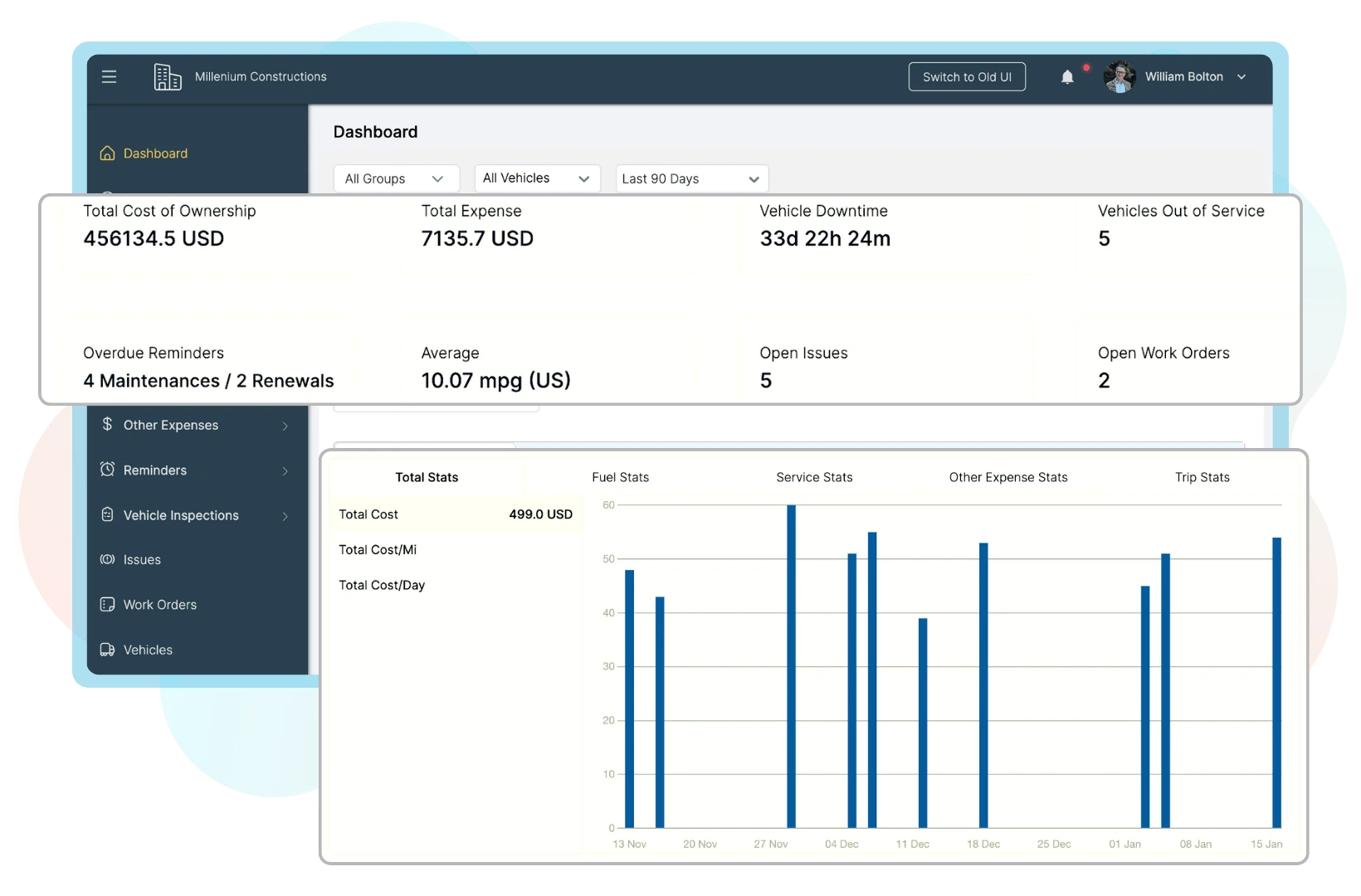Key Takeaways
- Efficient maintenance inventory management boosts uptime, reduces waste, and controls costs.
- The seven proven ways to improve it include:
- Standardize spare parts data to avoid duplicate records and confusion.
- Link work orders to inventory usage for accurate tracking and cost visibility.
- Use preventive maintenance scheduling to forecast part needs in advance.
- Set smart reorder points to prevent downtime and overstocking.
- Conduct regular cycle counts to maintain accurate inventory data.
- Adopt cloud-based inventory management software for real-time, remote visibility.
- Track maintenance costs to identify savings and improve financial control.
- Together, these strategies enhance fleet uptime, reduce repair delays, and improve long-term operational efficiency.
Managing maintenance inventory is about ensuring the right parts are available, at the right time, without tying up unnecessary capital. Fleet and equipment-based operations face unique challenges: unpredictable breakdowns, scattered service locations, and inconsistent usage rates.
To keep your fleet running smoothly, you need more than just a spreadsheet. You need strategy.
Here are 7 proven ways to improve maintenance inventory management, drawn from real-world fleet and equipment operations — each designed to enhance uptime, efficiency, and cost control.
1. Standardize Spare Parts Data
Inconsistent part naming and poor data structure are silent killers in maintenance management. Duplicate records, unclear descriptions, and missing supplier information can create confusion (especially when ordering or tracking critical spares).
Why it matters: When each technician or manager uses different names for the same part (for example, “front tire,” “F tire,” “Michelin 16-inch”), your inventory reports become unreliable. Mislabeling leads to overstocking, duplicate purchases, and downtime when the “right” part can’t be found.
Fleet Example: A logistics company standardizes tire data across its 60 trucks using a consistent naming format — Brand-Size-Type. Now, tire replacements are logged accurately in Simply Fleet, eliminating duplicates and improving reorder visibility.
Pro Tip: Use structured fields for part numbers, brands, and compatible equipment. Simply Fleet allows you to upload standardized inventory lists and apply consistent naming conventions across all assets.
2. Link Work Orders to Inventory Usage
When parts are pulled from stock but not logged against a work order, your inventory data loses accuracy. This “invisible consumption” inflates costs and creates stock discrepancies.
Why it matters: Linking work orders to inventory ensures every part is tracked against a specific repair. This helps calculate true maintenance costs per asset and reveals which machines or vehicles consume the most spares.
Construction Example: During an excavator’s hydraulic repair, a technician logs the work order in Simply Fleet. The hydraulic pump, filters, and seals are automatically deducted from inventory. This data later shows that the excavator model consumes 40% more hydraulic parts than others (helping managers reassess preventive schedules).
Pro Tip: Always integrate inventory usage with work order management. Simply Fleet automates this link, so every job instantly updates part levels in real-time.
3. Use Preventive Maintenance Scheduling to Forecast Inventory Needs
Reactive maintenance is expensive; not only because of emergency labor but also because of unplanned parts shortages. Preventive maintenance (PM) planning helps forecast future inventory requirements based on usage, time, or mileage.
Why it matters: When you know which parts will be replaced during upcoming PM cycles, you can order in advance, avoid rush deliveries, and minimize stockouts.
Fleet Example: A delivery fleet tracks oil filters, brake pads, and belts through Simply Fleet’s PM scheduling. Each vehicle triggers automatic reminders based on mileage, ensuring parts are available right before service is due (not after a breakdown).
Pro Tip: Use time, mileage, or engine-hour metrics to plan recurring services. Simply Fleet’s PM scheduler syncs with inventory, automatically adjusting future part requirements.
4. Set Smart Reorder Points for Critical Parts
Running out of critical parts like brake pads, filters, or sensors can cause costly downtime. But overstocking eats into working capital. Smart reorder points strike the right balance.
Why it matters:With proper reorder levels, you maintain availability for high-criticality parts while optimizing storage and procurement costs.
Facility Example: A facility management company tracks HVAC filters using Simply Fleet. When stock drops below five filters, the system automatically notifies procurement to reorder. This prevents last-minute shortages and ensures consistent air quality in client buildings.
Pro Tip: Base reorder points on lead time, consumption rate, and part criticality. Simply Fleet lets you set automated reorder alerts to keep stock healthy (not excessive).
5. Conduct Regular Cycle Counts
Annual inventory audits are outdated and inefficient. Regular cycle counts (smaller, more frequent checks) ensure your data remains accurate all year.
Why it matters: Small discrepancies caught early prevent large financial losses later. Continuous monitoring also highlights issues like theft, misplacement, or unrecorded part usage.
Fleet Example: A bus fleet performs cycle counts every week for 20 high-value items (like alternators and tires). Discrepancies are instantly reviewed in Simply Fleet, improving accuracy from 84% to 98% within three months.
Pro Tip: Use ABC analysis like count high-value (A) items weekly, medium-value (B) monthly, and low-value (C) quarterly. Simply Fleet’s reports help identify which items need frequent audits.
Download Your Free Fleet Maintenance Resources Now!
6. Use Cloud-Based Inventory Management Software
Spreadsheets and manual logs don’t cut it anymore. Cloud-based inventory management software provides real-time visibility, centralized data, and easy access for distributed teams.
Why it matters: Fleet managers and technicians can check part availability, log usage, and create purchase orders from any location; ensuring accurate, up-to-date information.
Fleet Example: A transport company with depots across three cities uses Simply Fleet’s cloud-based inventory system. When a technician in Chicago logs a brake replacement, the inventory updates instantly across all locations; preventing double-counting or over-ordering.
Pro Tip: Opt for a solution that integrates maintenance, work orders, and inventory in one dashboard. Simply Fleet’s mobile app ensures your data syncs automatically, no matter where your team operates.
7. Track Maintenance Costs to Find Savings Opportunities
Inventory is one of the largest cost components in maintenance operations. Tracking costs by asset, part type, and supplier can reveal hidden inefficiencies and savings opportunities.
Why it matters: When you know how much each asset consumes in parts, you can identify outliers, negotiate better vendor pricing, and decide whether repair or replacement is more cost-effective.
Fleet Example: A trucking company uses Simply Fleet’s analytics dashboard to compare tire expenses across vehicles. The data shows one model incurs 25% higher tire costs due to misalignment issues. Fixing alignment schedules saves over $8,000 annually.
Pro Tip: Use detailed reports to monitor part costs, supplier performance, and maintenance ROI. Simply Fleet’s cost-tracking dashboard visualizes expenses by vehicle, part, and month.

Conclusion & Next Steps
Maintenance inventory management doesn’t have to be chaotic. By standardizing data, linking work orders, forecasting needs, setting smart reorder points, conducting cycle counts, using cloud-based tools, and tracking costs your fleet can operate more efficiently than ever. These proven methods lead to fewer stockouts, faster repairs, and smarter spending.
Ready to see how Simply Fleet simplifies inventory tracking for fleets and equipment? Request a free demo of Simply Fleet today and experience real-time control over every part, purchase, and performance metric.



.png)








.png)


.png)
.webp)








